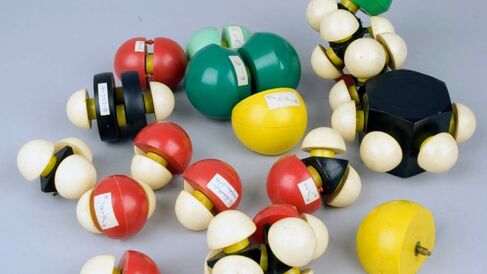Modelling Chemistry

Models are essential to teaching and research in chemistry. It is useful for students to see an accurate model of a molecule's shape when they are solving a problem. Also, models have been key elements in 20th century chemical discoveries, such as the structure of the DNA molecule. Many types of molecular models exist, each emphasising different information about the molecule.
Why make molecular models?
Models of molecules show the position of the different atoms, more or less to scale and usually with colour coding, and demonstrate how they are bonded together. Chemists don't think that models such as these show what molecules 'really look like'; models are useful tools for visualising the structures and shapes of groups of atoms, which is important in understanding their behaviour. You can feel the shape of the atom groups and investigate how the molecule can move or bend.
Models have been used to represent arrangements of atoms throughout the development of modern atomic theory. The Science Museum in London has wooden models of atoms used by John Dalton (1766-1844) in his lectures. However, it has been suggested that Kepler used models to depict atoms as early as 1611. All of the sets of models in the Whipple Museum date from the 20th century.
Types of molecular models
There are several main types of atomic models in use today: two of the most common are 'ball and spoke' and 'space-filling' types; each is useful for displaying different information about the molecules. Whilst ball and spoke models are designed to show how the atoms are bonded together, space-filling models accurately demonstrate the size and shape of the molecule.
Most sets of models differentiate between different types of atoms using colours, whilst some vary the size of the atoms, often to allow visually impaired people to use the sets.
What colour is an atom?
We don't think about single atoms of elements as having a colour. It is only on a much bigger scale that solids (and some liquids and gases) display colours. The colours used in modelling kits are chosen for identification purposes and do not correspond to any actual colour in the atoms. Although oxygen atoms are coloured red in kits, liquid oxygen is actually blue in colour.
There are several conventions for the colours of molecular models. Many use the colour scheme shown in the table below, which was recommended by the Institute of Physics.(1) Models using this scheme include the plastic space-filling models developed by Corey and Pauling, and later improved on by Kultun (known as CPK models). Not all models use this convention though; in the Griffin and George model set, the colours were chosen on the basis of how clearly they would show up in black and white photographs.
The Institute of Physics recommended colour scheme for molecular models
Element | Atom colour |
| carbon | black |
| hydrogen | white or cream |
| oxygen | red |
| nitrogen | blue |
| fluorine | yellowish green |
| chlorine | light green |
| bromine | mid-green |
| iodine | dark green |
| sulphur | yellow |
| phosphorus | purple |
References
- Institute of Physics, 'The standardisation of crystal structure models', Journal of Scientific Instruments, Vol. 24, no. 9 (1947), 249-250.
Further reading
- A. Walton, Molecular & Crystal Structure Models (Chichester: Ellis Horwood Limited, 1978).
- E. Francoeur, 'The forgotten tool: the design and use of molecular models', Social Studies of Science, Vol. 27, No. 1 (1997), 7-40.
Ruth Horry
Ruth Horry, 'Modelling chemistry', Explore Whipple Collections, Whipple Museum of the History of Science, University of Cambridge, 2008.
